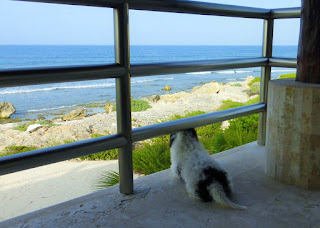 |
| Perfect turtle egg-laying weather |
Yep, that’s what the title
says: landscaping by turtles.
I know, I know this is the
second article in two months about turtles, but this is turtle season, folks!
We
are in the middle of the nesting season with possibly the largest number of returning
turtles since the turtle farm came into existence about twenty years ago.
 |
| Dozens of nesting holes |
Hundreds and hundreds of
the ladies are nightly digging up the beaches, creating four-foot deep holes on
any small piece of sand on the eastern side of Isla Mujeres. The beaches look
like a Bobcat earth mover has been at work, operated by someone like me, someone
with a very short attention span. “I’m
bored with this hole, I think I’ll make another one over there, oh wait, that’s
a better spot.” And on, and on, into the
night.
 |
| Sparky sniffing the mess left by the mama turtle |
A few weeks ago, around
mid-night, Sparky our little four-legged alarm system woke us with a woof.
Lawrie and I popped out of bed to investigate the strange noise coming
from our ocean-side yard. It sounded as
if someone was shovelling sand, preparing to bury a body. (You can tell, we read a lot of murder
mysteries and thrillers.)
A quick flick
of the flashlight and we spotted a large sea turtle deep in the bushes on the
south side of the house, violently flipping rocks and sand. We wanted to help her find a better spot, but
decided that she had to make her own decisions about the suitability of the
location for her nest. In the end, she
abandoned the attempt and moved on to another place.
 |
| Eggs were dug up by another mama turtle |
The downside of so much
nesting activity is that many of the eggs are not being collected by the turtle
farm for hatching in their predator-free environment. I have recently seen at least six large nests
that have been re-dug the following night by another mama turtle, scattering
eggs across the beach, crushing the fragile spheres with her large body. It’s unfortunate. Presumably, the turtle farm hatchery is filled
to capacity. The upside of the extra
eggs is that the crabs and birds are happily feasting on the embryos, increasing
their chances of producing more baby crabs or baby birds.
 |
| Mayan Riviera Sargassum seaweed |
Besides the challenge of
finding a suitable place to nest, the mama turtles are facing another weird
environmental phenomenon this year – Sargassum seaweed. Literally tons of seaweed have been drifting
in mats of vegetation and washing up on beaches throughout the Gulf of Mexico
and the Caribbean Sea. It is an
unsightly mess causing problems in resort areas, especially the Mayan Riviera
and Cancun. The Sargassum seaweed is an
algae that originates mid-Atlantic in the warm-bodied Sargasso Sea. The reason for the problem is perplexing
scientists and environmentalists everywhere.
 |
| Tracks through neighbours' yard into ours. |
We have often wondered why
the mama turtles seem to congregate on the eastern side of the island, instead
of using the longer, flatter, and much softer beaches on the western side, the
side facing Cancun.
Is it because our
beaches are more visible as the ladies arrive back at their home base? Or is it just more expedient after mating to
hit the first available beach and offload all those pesky eggs?
The ladies expend so much effort digging in
the rocky sand on the eastern side, I would think a few extra minutes spent
scouting out a better location would be worth the time, wouldn’t it?
As you can probably guess, we really enjoy watching
the show in turtle season. They are
pretty darn amazing creatures.
We wish you a long and
peaceful life, my friends.
Hasta luego, Lynda, Lawrie, Sparky, and Thomas


%20Instagram%20%231%20(2).jpg)



















